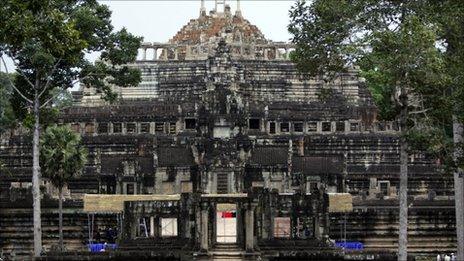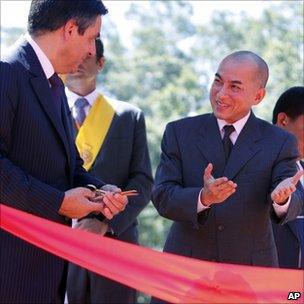Cambodia completes Angkor temple renovation 'puzzle'
- Published

The intricately-carved, three-tiered temple dates back to the 11th Century
An ancient Angkor temple has re-opened in Cambodia following decades of reconstruction work - a task described as the world's largest puzzle.
The work has involved taking apart the Baphuon monument's 300,000 sandstone blocks and piecing them back together.
The project began in the 1960s but was interrupted by Cambodia's civil war, and restarted in the mid-1990s.
The 11th-Century three-tier tower is part of the Angkor complex which draws two million tourists a year.
Numbered blocks
The re-opening was marked by a ceremony attended by Cambodian King Norodom Sihamoni and French Prime Minister Francois Fillon.
"The work at Baphuon has been exceptional," Mr Fillon said.
Meanwhile, King Sihamoni expressed "profound gratitude to France" for funding the 10m-euro ($14m; £9m) project.

French Prime Minister Francois Fillon said the work on the temple was "exceptional"
The BBC's Guy De Launey in Phnom Penh says the Baphuon was once among the finest of the great monuments of Angkor, but by the 1950s it was on the brink of collapse.
A French-led team of archaeologists decided that the only way to save the temple was to take it apart, our correspondent says.
They dismantled the monument, laying all the stone blocks in the surrounding jungle. Each piece was painted with a number, matching an entry on the master plan, so the tower could be rebuilt.
But work was disrupted by the civil war and the records needed to reconstruct it were destroyed by the Khmer Rouge, a hardline communist regime that took power in 1975.
The reconstruction was only restarted in 1995.
Pascal Royere, who has been overseeing the project, said the early years had been the hardest.
"We were facing a three-dimensional puzzle, a 300,000-piece puzzle to which we had lost the picture. And that was the main difficulty of this project," Mr Royere told AFP news agency.
"There is no mortar that fills the cracks which means that each stone has its own place. You will not find two blocks that have the same dimensions."
Our correspondent says that some pieces - more than 10,000 - are left over, and dot the forest floor surrounding the temple.
The Angkor region was the seat of the medieval Khmer empire.